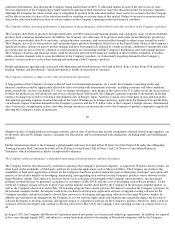Apple 2002 Annual Report Download - page 36
Download and view the complete annual report
Please find page 36 of the 2002 Apple annual report below. You can navigate through the pages in the report by either clicking on the pages listed below, or by using the keyword search tool below to find specific information within the annual report.
The Company's future effective tax rates could be favorably or unfavorably affected by unanticipated changes in the mix of earnings in
countries with differing statutory tax rates, changes in the valuation of the Company deferred tax assets and liabilities, or by changes in tax
laws or their interpretation.
The Company's stock price may be volatile.
The Company's stock has at times experienced substantial price volatility as a result of variations between its actual and anticipated financial
results and as a result of announcements by the Company and its competitors. In addition, the stock market has experienced extreme price and
volume fluctuations that have affected the market price of many technology companies in ways that have been unrelated to the operating
performance of these companies. These factors, as well as general economic and political conditions and investors' concerns regarding the
credibility of corporate financial reporting and integrity of financial markets, may materially adversely affect the market price of the
Company's common stock in the future.
44
Item 7A. Disclosures About Market Risk
Interest Rate and Foreign Currency Risk Management
To ensure the adequacy and effectiveness of the Company's foreign exchange and interest rate hedge positions, as well as to monitor the risks
and opportunities of the non-hedge portfolios, the Company continually monitors its foreign exchange forward and option positions, and its
interest rate swap and option positions both on a stand-alone basis and in conjunction with its underlying foreign currency and interest rate
related exposures, respectively, from both an accounting and an economic perspective. However, given the effective horizons of the Company's
risk management activities and the anticipatory nature of the exposures intended to hedge, there can be no assurance the aforementioned
programs will offset more than a portion of the adverse financial impact resulting from unfavorable movements in either foreign exchange or
interest rates. In addition, the timing of the accounting for recognition of gains and losses related to mark-to-market instruments for any given
period may not coincide with the timing of gains and losses related to the underlying economic exposures and, therefore, may adversely affect
the Company's operating results and financial position. The Company adopted Statement of Financial Accounting Standard No. 133,
Accounting for Derivative Instruments and Hedging Activities
, as of October 1, 2000. SFAS No. 133 establishes accounting and reporting
standards for derivative instruments, hedging activities, and exposure definition. Management does not believe that ongoing application of
SFAS No. 133 will significantly alter the Company's hedging strategies. However, its application may increase the volatility of other income
and expense and other comprehensive income.
Interest Rate Risk
While the Company is exposed to interest rate fluctuations in many of the world's leading industrialized countries, the Company's interest
income and expense is most sensitive to fluctuations in the general level of U.S. interest rates. In this regard, changes in U.S. interest rates
affect the interest earned on the Company's cash, cash equivalents, and short-
term investments as well as costs associated with foreign currency
hedges.
The Company's fixed income investment policy and strategy is to ensure the preservation of capital, meet liquidity requirements, and optimize
return in light of the current credit and interest rate environment. The Company benchmarks its performance by utilizing external money
managers to manage a small portion of the aggregate investment portfolio. The external managers adhere to the Company's investment policies
and also provide occasional research and market information that supplements internal research used to make credit decisions in the investment
process.
During 1994, the Company issued $300 million aggregate principal amount of 6.5% unsecured notes in a public offering registered with the
SEC. The notes were sold at 99.925% of par, for an effective yield to maturity of 6.51%. The notes pay interest semiannually and mature on
February 15, 2004.
The Company's exposure to market risk for changes in interest rates relates primarily to the Company's investment portfolio and long-
term debt
obligations and related derivative financial instruments. The Company places its short-term investments in highly liquid securities issued by
high credit quality issuers and, by policy, limits the amount of credit exposure to any one issuer. The Company's general policy is to limit the
risk of principal loss and ensure the safety of invested funds by limiting market and credit risk. All highly liquid investments with maturities of
three months or less are classified as cash equivalents; highly liquid investments with maturities greater than three months are classified as
short-term investments. As of September 28, 2002, $1.087 billion of the Company's investment portfolio classified as short-term investments
was invested in U.S. Agency and corporate debt securities with maturities ranging from 1 to 5 years. As of September 29, 2001, $313 million
of the Company's investment portfolio classified as short-term investments was in U.S. agency securities with underlying maturities ranging
from 1 to 4 years. The remainder all had underlying maturities between 3 and 12 months. Due to liquidity needs, or in anticipation of credit
deterioration, or for the purpose of duration management of the Company's
























